Dreams, Spirits & the Occult: The Secret World of Carl G Jung
BY GARY LACHMAN
From New Dawn 174 (May-June 2019)
On 11 February 1944, the 68-year-old Carl Gustav Jung – then the world’s most renowned living psychologist – slipped on some ice and broke his fibula. Ten days later, in hospital, he suffered a myocardial infarction caused by embolisms from his immobilised leg. Treated with oxygen and camphor, he lost consciousness and had what seems to have been a near-death and out-of-the-body experience – or, depending on your perspective, delirium.
He found himself floating 1,000 miles above the Earth. Seas and continents shimmered in blue light and Jung could make out the Arabian desert and snow-tipped Himalayas. He felt he was about to leave orbit, but then, turning to the south, a huge black monolith came into view. It was a kind of temple, and at the entrance Jung saw a Hindu sitting in a lotus position. Within, innumerable candles flickered, and he felt that the “whole phantasmagoria of earthly existence” was being stripped away. It wasn’t pleasant, and what remained was an “essential Jung,” the core of his experiences.
He knew that inside the temple the mystery of his existence, of his purpose in life, would be answered. He was about to cross the threshold when he saw, rising up from Europe far below, the image of his doctor in the archetypal form of the King of Kos, the island site of the temple of Asclepius, Greek god of medicine. He told Jung that his departure was premature; many were demanding his return and he, the King, was there to ferry him back. When Jung heard this, he was immensely disappointed, and almost immediately the vision ended.
He experienced the reluctance to live that many who have been ‘brought back’ encounter, but what troubled him most was seeing his doctor in his archetypal form. He knew this meant that the physician had sacrificed his own life to save Jung’s. On 4 April 1944 – a date numerologists can delight in – Jung sat up in bed for the first time since his heart attack. On the same day, his doctor came down with septicæmia and took to his bed. He never left it, and died a few days later.
Jung was convinced that he hadn’t simply hallucinated, but that he had been granted a vision of reality. He had passed outside time, and the experience had had a palpable effect on him. For one thing, the depression and pessimism that overcame him during WWII vanished. But there was something more. For most of his long career, he had impressed upon his colleagues, friends, and reading public that he was, above all else, a scientist. He was not, he repeated almost like a mantra, a mystic, occultist, or visionary, terms of abuse his critics, who rejected his claims to science, had used against him. Now, having returned from the brink of death, he seemed content to let the scientist in him take a back seat for the remaining 17 years of his life.
Although Jung had always believed in the reality of the ‘other’ world, he had taken care not to speak too openly about this belief. Now, after his visions, he seemed less reticent. He’d had, it seems, a kind of conversion experience, and the interests the world-famous psychologist had hitherto kept to himself now became common knowledge. Flying saucers, astrology, parapsychology, alchemy, even predictions of a coming “new Age of Aquarius”: pronouncements on all of these dubious subjects – dubious at least from the viewpoint of modern science – flowed from his pen. If he had spent his career fending off charges of mysticism and occultism – initially triggered by his break with Freud in 1912 – by the late 1940s he seems to have decided to stop fighting. The “sage of Küsnacht” and “Hexenmeister of Zürich,” as Jung was known in the last decade of his life, had arrived.
All in the Family
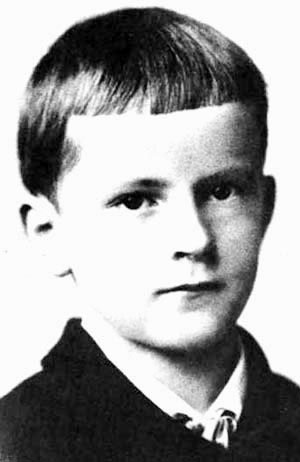
Yet Jung’s involvement with the occult was with him from the start – literally, it was in his DNA. His maternal grandfather, Rev. Samuel Preiswerk, who learned Hebrew because he believed it was spoken in heaven, accepted the reality of spirits, and kept a chair in his study for the ghost of his deceased first wife, who often came to visit him. Jung’s mother Emilie was employed by Samuel to shoo away the dead who distracted him while he was working on his sermons.
She herself developed mediumistic powers in her late teens. At the age of 20, she fell into a coma for 36 hours; when her forehead was touched with a red-hot poker she awoke, speaking in tongues and prophesying. Emilie continued to enter trance states throughout her life, in which she would communicate with the dead. She also seems to have been a ‘split personality’. Jung occasionally heard her speaking to herself in a voice he soon recognised was not her own, making profound remarks expressed with an uncharacteristic authority. This ‘other’ voice had inklings of a world far stranger than the one the young Carl knew.
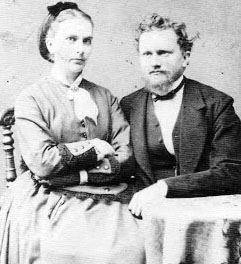
This ‘split’ that Jung had seen in his mother would later appear in himself. At around the age of 12, he literally became two people. There was his ordinary boyhood self, and someone else. The ‘Other’, as Carl called him, was a figure from the 18th century, a masterful character who wore a white wig and buckled shoes, drove an impressive carriage, and held the young boy in contempt. It’s difficult to escape the impression that in some ways Jung felt he had been this character in a past life. Seeing an ancient green carriage, Jung felt that it came from his time.
His later notion of the collective unconscious, that psychic reservoir of symbols and images that he believed we inherit at birth, is in a sense a form of reincarnation, and Jung himself believed in some form of an afterlife. Soon after the death of his father, in 1896 when Jung was 21, he had two dreams in which his father appeared so vividly that he considered the possibility of life after death. In another, later dream, Jung’s father asked him for marital advice, as he wanted to prepare for his wife’s arrival. Jung took this as a premonition, and his mother died soon after. And years later, when his sister Gertrude died – a decade before his own near-death experience – Jung wrote that, “What happens after death is so unspeakably glorious that our imagination and feelings do not suffice to form even an approximate conception of it.”1
Tables & Knives
Jung’s mother was involved in at least two well-known paranormal experiences that are recounted in practically every book about him. Sitting in his room studying, Carl suddenly heard a loud bang coming from the dining room. He rushed in and found his mother startled. The round walnut table had cracked from the edge past the centre. The split didn’t follow any joint but had passed through solid wood. Drying wood couldn’t account for it; the table was 70 years old and it was a humid day. Jung thought: “There certainly are curious accidents.” As if she was reading his mind Emilie replied in her ‘other’ voice: “Yes, yes, that means something.”
Two weeks later came a second incident. Returning home in the evening, Jung found an excited household. An hour earlier there had been another loud crack, this time coming from a large sideboard. No one had any idea what had produced it. Jung inspected the sideboard. Inside, where they kept the bread, he found a loaf and the bread knife. The knife had shattered into several pieces, all neatly arranged in the breadbasket. The knife had been used earlier for tea, but no one had touched it nor opened the cupboard since. When he took the knife to a cutler, he was told that there was no fault in the steel and that someone must have broken it on purpose. He kept the shattered knife for the rest of his life, and years later sent a photograph of it to psychical researcher JB Rhine.
Spirits Afoot
By this time Jung, like many others, was interested in spiritualism, and was reading through the literature – books by Zöllner, Crooks, Carl du Prel, Swedenborg, and Justinus Kerner’s classic The Seeress of Prevorst. At the Zofingia debating society at the University of Basel, he gave lectures on “The Value of Speculative Research” and “On the Limits of Exact Science,” in which he questioned the dominant materialist paradigm that reigned then, as today. Jung led fellow students in various occult experiments, yet when he spoke to them about his ideas, or lectured about the need to take them seriously, he met with resistance. Apparently, he had greater luck with his dachshund, whom he felt understood him better and could feel supernatural presences himself.2
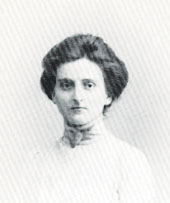
Another who seemed to feel supernatural presences was his cousin, from his mother’s side of the family, Helene Preiswerk. In a letter to JB Rhine about the shattered bread knife, Jung refers to Helly – as she was known – as a “young woman with marked mediumistic faculties” whom he had met around the time of the incident, and in his “so-called’ autobiography Memories, Dreams, Reflections he remarks that he became involved in a series of séances with his relatives after the incidents of the bread knife and table. Yet the séances had been going on for some time before the two events, and at their centre was Helly, whom Jung already knew well and who, by all accounts, was in love with him. This is an early sign of his somewhat ambiguous relationship with the occult.
Helly would enter a trance and fall to the floor, breathing deeply, and speaking in old Samuel Preiswerk’s voice – although she had never heard him. She told the others that they should pray for her elder sister Bertha, who, she said, had just given birth to a black child. Bertha, who was living in Brazil, had already had one child with her mixed-race husband, and gave birth to another on the same day as the séance.3 Further séances proved equally startling. At one point, Samuel Preiswerk and Carl Jung Sr – Jung’s paternal grandfather – who had disliked each other while alive, reached a new accord. A warning came for another sister who was also expecting a child that she would lose it; in August the baby was born premature and dead.4
Helly produced further voices, but the most interesting was a spirit named Ivenes, who called herself the real Helene Preiswerk. This character was much more mature, confident, and intelligent than Helly, who Jung described as absent-minded, and not particularly bright, talented, or educated. It was as if buried beneath the unremarkable teenager was a fuller, more commanding personality, like Jung’s ‘Other’. This was an insight into the psyche that would inform his later theory of “individuation,” the process of “becoming who you are.” Helly did blossom later, becoming a successful dressmaker in France, although she died young, at only 30.
In Jung’s dissertation on the séances, On the Psychology and Pathology of So-called Occult Phenomena, he describes Helly unflatteringly as “exhibiting slightly rachitic skull formation,” and “somewhat pale facial colour,” and fails to mention that she is his cousin. He also omits his own participation in the séances, and dates them from 1899 to 1900, whereas they had started years before. Gerhard Wehr politely suggests that, “[T]he doctoral candidate was obviously at pains to conceal his own role, and especially his close kinship relationship, thus forestalling from the start any further critical inquiry that might have thrown the scientific validity of the entire work into question.”5
In other words, Jung the scientist thought it a good career move to obscure Jung the occultist’s personal involvement in the business.
The Poltergeist in Freud’s Bookcase
In 1900, the 25-year-old Jung joined the prestigious Burghölzli Mental Clinic in Zürich. Here, he did solid work in word-association tests, developed his theory of ‘complexes’, and initiated a successful ‘patient-friendly’ approach to working with psychotics and schizophrenics. It was during his tenure that he also became involved with Freud. From 1906, when they started corresponding, to 1912, when the friendship ruptured, Jung was a staunch supporter of Freud’s work and promoted it unstintingly.

There were, however, some rocky patches. One centred on the famous poltergeist in Freud’s bookcase. Visiting Freud in Vienna in 1909, Jung asked him about his attitude toward parapsychology. Freud was sceptical and dismissed the subject as nonsense. Jung disagreed, and sitting across from the master, he began to feel his diaphragm glow, as if it was becoming red-hot. Suddenly a loud bang came from a bookcase. Both jumped up, and Jung said to Freud: “There, that is an example of a so-called catalytic exteriorisation phenomenon!”, Jung’s long-winded circumlocution for a poltergeist, or “noisy spirit.” When Freud said “Bosh!”, Jung predicted that another bang would immediately happen. It did. Jung said that, from that moment on, Freud grew mistrustful of him. From Freud’s letter to Jung about the incident, one gets the feeling that he felt Jung himself was responsible for it.
This isn’t surprising; Jung did manifest numerous paranormal abilities. While in bed in a hotel room after giving a lecture, he experienced the suicide of a patient who had a strong “transference” on him. The patient had relapsed into depression and shot himself in the head. Jung awoke in his hotel, feeling an odd pain in his forehead. He later discovered that his patient had shot himself precisely where Jung felt the pain, at the same time Jung woke up. More to the point, a visitor to his home once remarked about Jung’s “exteriorised libido,” how “when there was an important idea that was not yet quite conscious, the furniture and woodwork all over the house creaked and snapped.”
The Red Book
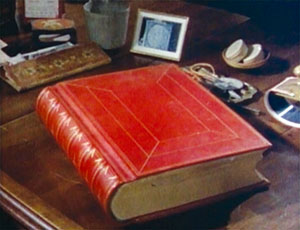
It was Jung’s break with Freud that led to his own ‘descent into the unconscious,’ a disturbing trip down the psyche’s rabbit hole from which he gathered the insights about the collective unconscious that would inform his own school of ‘analytical psychology’. He had entered a ‘creative illness’, unsure if he was going mad. In October 1913, not long after the split, Jung had, depending on your perspective, a vision or hallucination. While on a train, he suddenly saw a flood covering Europe, between the North Sea and the Alps. When it reached Switzerland, the mountains rose to protect his homeland, but in the waves he saw floating debris and bodies. Then the water turned to blood. The vision lasted an hour and seems to have been a dream that had invaded his waking consciousness. Having spent more than a decade treating mental patients who suffered from precisely such symptoms, Jung had reason to be concerned. He was ironically rather relieved the next summer when WWI broke out and he deduced that his vision had been a premonition of it.
Yet the psychic tension continued. Eventually there came a point where Jung felt he could no longer fight off the sense of madness. He decided to let go. When he did, he landed in an eerie, subterranean world where he met strange intelligences that ‘lived’ in his mind. The experience was so upsetting that for a time Jung slept with a loaded pistol by his bed, ready to blow his brains out if the stress became too great.
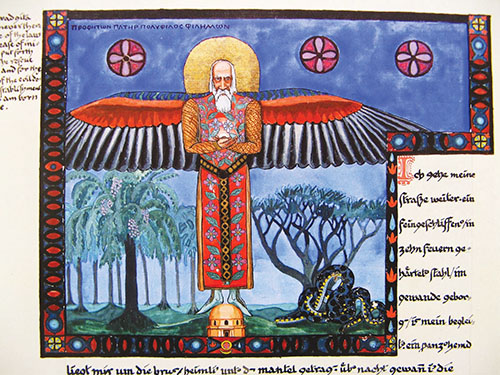
In his Red Book he kept an account, in words and images, of the objective, independent entities he encountered during his “creative illness” – entities that had nothing to do with him personally, but who shared his interior world. There were Elijah and Salome, two figures from the Bible who were accompanied by a snake. There was also a figure whom Jung called Philemon, who became a kind of ‘inner guru’ and who he painted as a bald, white-bearded old man with bull’s horns and the wings of a kingfisher. One morning, after painting the figure, Jung was out taking a walk when he came upon a dead kingfisher. The birds were rare in Zürich and he had never before come upon a dead one. This was one of the many synchronicities – “meaningful coincidences” – that happened at this time.
There were others. In 1916, still in the grip of his crisis, Jung again felt that something within wanted to get out. An eerie restlessness filled his home. He felt the presence of the dead – and so did his children. One daughter saw a strange white figure; another had her blankets snatched from her at night. His son drew a picture of a fisherman he had seen in a dream: a flaming chimney rose from the fisherman’s head, and a devil flew through the air, cursing the fisherman for stealing his fish. Jung had yet to mention Philemon to anyone. Then, one afternoon, the doorbell rang loudly, but no one was there. He asked: “What in the world is this?” The voices of the dead answered: “We have come back from Jerusalem where we found not what we sought,” words that form the beginning of Jung’s strange Seven Sermons to the Dead, a work of “spiritual dictation,” or “channelling,” he attributed to “Basilides in Alexandria, the City where the East toucheth the West.”
Ghosts in the House
By 1919, WWI was over and Jung’s crisis had passed, although he continued to practise what he called “active imagination,” a kind of waking dreaming, the results of which he recorded in the Red Book. But spirits of a more traditional kind were not lacking. He was invited to London to lecture on “The Psychological Foundations of the Belief in Spirits” to the Society for Psychical Research. He told the Society that ghosts and materialisations were “unconscious projections.” “I have repeatedly observed,” he said, “the telepathic effects of unconscious complexes, and also a number of parapsychic phenomena, but in all this I see no proof whatever of the existence of real spirits, and until such proof is forthcoming I must regard this whole territory as an appendix of psychology.”
Scientific enough, no doubt, but a year later, again in England, he encountered a somewhat more real ghost. He spent some weekends in a cottage in Aylesbury rented by Maurice Nicoll (later a student of Gurdjieff and Ouspensky) and while there was serenaded by eerie sounds, while an unpleasant smell filled the bedroom. Locals said the place was haunted and, on one particularly bad night, Jung discovered an old woman’s head on the pillow next to his; half of her face was missing. He leapt out of bed and waited until morning in an armchair. The house was later torn down. One would think that, having already encountered the dead on their return from Jerusalem, Jung wouldn’t be so shaken by a traditional English ghost, but the experience rattled him; his account of it only appeared 30 years later, in 1949, in an obscure anthology of ghost stories.
When his lecture for the SPR was reprinted in the Collected Works in 1947, Jung added a footnote explaining that he no longer felt as certain as he did in 1919 that apparitions were explicable through psychology, and that he doubted “whether an exclusively psychological approach can do justice to the phenomenon.” In a later postscript, he again admitted that his earlier explanation was insufficient, but that he couldn’t agree on the reality of spirits because he had no experience of them – conveniently forgetting the haunting in Aylesbury. But in a letter of 1946 to Fritz Kunkel, a psychotherapist, Jung admitted: “Metapsychic phenomena could be explained better by the hypothesis of spirits than by the qualities and peculiarities of the unconscious.”
A similar uncertainty surrounds his experience with the I Ching, the ancient Chinese oracle, with which he began to experiment in the early 1920s and which, like horoscopes, became part of his therapeutic practice. Although he mentioned the I Ching here and there in his writing, it wasn’t until 1949, again nearly 30 years later, in his introduction to the classic Wilhelm/Baynes translation, that he admitted outright to using it himself. And although he tried to explain the I Ching’s efficacy through what would become his paranormal deus ex machina, synchronicity, Jung admits that the source of the oracle’s insights are the “spiritual agencies” that form the “living soul of the book,” a remark at odds with his quasi-scientific explanation. Ironically, his major work on “meaningful coincidence,” Synchronicity: An Acausal Connecting Principle (1952), written with the physicist Wolfgang Pauli, provides only one unambiguous example of the phenomenon, and readers who, like me, accept the reality of synchronicity, come away slightly baffled by Jung’s attempt to account for it via archetypes, quantum physics, statistical analysis, mathematics, JB Rhine’s experiments with ESP, astrology, telepathy, precognition, and other paranormal abilities, all of which read like a recrudescence of Jung’s “I am a scientist” reflex.
Age of Aquarius
In the 1920s, he plunged into a study of the Gnostics – whom he had encountered as early as 1912 – and alchemy. It was Jung, more than anyone else, who salvaged the ancient Hermetic pursuit from intellectual oblivion. Another Hermetic practice he followed was astrology, which he began to study seriously around the time of his break with Freud. Jung informed his inner circle that casting horoscopes was part of his therapeutic practice, but it was during the dark days of WWII that he recognised a wider application. In 1940, in a letter to HG Baynes, Jung speaks of a vision he had in 1918 in which he saw “fire falling like rain from heaven and consuming the cities of Germany.” He felt that 1940 was the crucial year, and he remarks that it’s “when we approach the meridian of the first star in Aquarius.” It was, he said, “the premonitory earthquake of the New Age.”
He was familiar with the precession of the equinoxes, the apparent backward movement of the Sun through the signs of the zodiac. By acting as a backdrop to sunrise at the vernal equinox, each sign gives its name to an ‘age’ – called a ‘Platonic month’ – which lasts roughly 2,150 years. In his strange book Aion (1951), he argues that the ‘individuation’ of Western civilisation as a whole follows the path of the ‘Platonic months’ and presents a kind of “precession of the archetypes.” Fish symbolism surrounds Jesus because He was the central symbol of the Age of Pisces, the astrological sign of the fish. Previous ages – of Taurus and Aries – produced bull and ram symbolism. The coming age is that of Aquarius, the Water Bearer. In conversation with Margaret Ostrowski-Sachs, a friend of Hermann Hesse, Jung admitted that he had kept this “secret knowledge” to himself for years, and only finally made it public in Aion. He wasn’t sure he was “allowed” to, but during his illness he received “confirmation” that he should.
Although the arcane scholar Gerald Massey and the French esotericist Paul Le Cour had earlier spoken of a coming Age of Aquarius, Jung was certainly the most prestigious mainstream figure to do so, and it is through him that the idea became a mainstay of the counterculture of the 1960s and ’70s. This was mostly through his comments about it in his book Flying Saucers: A Modern Myth of Things Seen in the Sky (1958), in which he argued that UFOs were basically mandalas from outer space. During his crisis, he had come upon the image of the mandala, the Sanskrit ‘magic circle’, as a symbol of psychic wholeness, and he suggested that ‘flying saucers’ were mass archetypal projections, formed by the psychic tension produced by the Cold War that was heating up between Russia and America. The Western world, he argued, was having a nervous breakdown, and UFOs were a way of relieving the stress.
Jung wrote prophetically: “My conscience as a psychiatrist bids me fulfil my duty and prepare those few who will hear me for coming events which are in accord with the end of an era… As we know from ancient Egyptian history, they are symptoms of psychic changes that always appear at the end of one Platonic month and at the beginning of another. They are, it seems, changes in the constellation of the psychic dominants, of the archetypes or ‘Gods’ as they used to be called, which bring about… long-lasting transformations of the collective psyche. This transformation started… in the transition of the Age of Taurus to that of Aries, and then from Aries to Pisces, whose beginning coincides with the rise of Christianity. We are now nearing that great change… when the spring-point enters Aquarius…” Ten years later, The Fifth Dimension (whose very name, appropriated from the title song of The Byrds’ third LP, suggests the cosmic character of the Mystic Sixties) had a hit song from the hippie musical Hair echoing Jung’s ideas, and millions of people all over the world believed they were witnessing “the dawning of the Age of Aquarius.”
Jung the Mystic
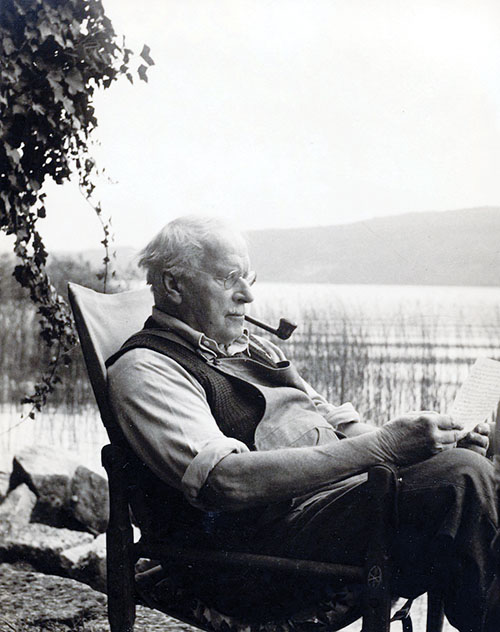
Jung died in 1961, just on the cusp of the ‘occult revival’ of the 1960s, a renaissance of magical thinking that he did much to bring about. He was also directly responsible for the “journey to the East” that many took then, and continue to take today. Along with the I Ching, Jung gave his imprimatur to such hitherto arcane items as The Tibetan Book of the Dead, Taoism and Zen, and without his intervention it’s debatable if these Eastern imports would have enjoyed their modern popularity. That he was in many ways a founding father of the Love Generation is seen by his inclusion on the cover of the Beatles’ Sgt Pepper’s Lonely Hearts Club Band album, although Jung himself would have thought “flower power” sadly naïve.
Although for all his efforts he has never been accepted by mainstream intellectuals, his effect on popular culture has been immense, and our contemporary grass roots, inner-directed spirituality, unfortunately associated with the New Age, has his name written all over it. Jung himself may have been equivocal about his relationship with mysticism, magic, and the occult, but the millions of people today who pay attention to their dreams, notice strange coincidences and consult the I Ching have the Sage of Küsnacht to thank for it.
The above article first appeared in Fortean Times 265 and is reprinted with the kind permission of the author.
FOOTNOTES
1. Quoted in Vincent Brome, Jung: Man and Myth, Scientific Book Club, 1979, 277
2. Brome, op. cit., 68
3. Deidre Bair, Jung: A Biography, Little Brown, 2004, 48
4. Ibid., 49
5. Gerhard Wehr, Jung: A Biography, Shambhala, Boston, 1987, 72
© New Dawn Magazine and the respective author.
For our reproduction notice, click here.
About the Author
![]() Gary Lachman was born in Bayonne, New Jersey, but has lived in London, England since 1996. A founding member of the rock group Blondie, he is now a full time writer with more than a dozen books to his name, on topics ranging from the evolution of consciousness and the western esoteric tradition, to literature and suicide, and the history of popular culture. Lachman writes frequently for many journals in the US and UK, and lectures on his work in the US, UK, and Europe. His work has been translated into several languages. His website is www.garylachman.co.uk.
Gary Lachman was born in Bayonne, New Jersey, but has lived in London, England since 1996. A founding member of the rock group Blondie, he is now a full time writer with more than a dozen books to his name, on topics ranging from the evolution of consciousness and the western esoteric tradition, to literature and suicide, and the history of popular culture. Lachman writes frequently for many journals in the US and UK, and lectures on his work in the US, UK, and Europe. His work has been translated into several languages. His website is www.garylachman.co.uk.
Come Follow Us on Twitter – Come Like Us on Facebook
Check us out on Instagram – And Sign Up for our Newsletter



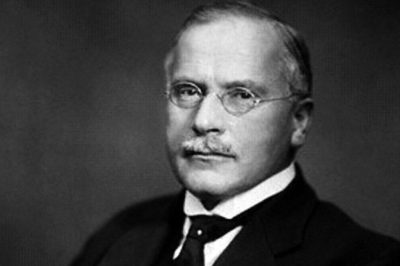
 www.newdawnmagazine.com
www.newdawnmagazine.com






